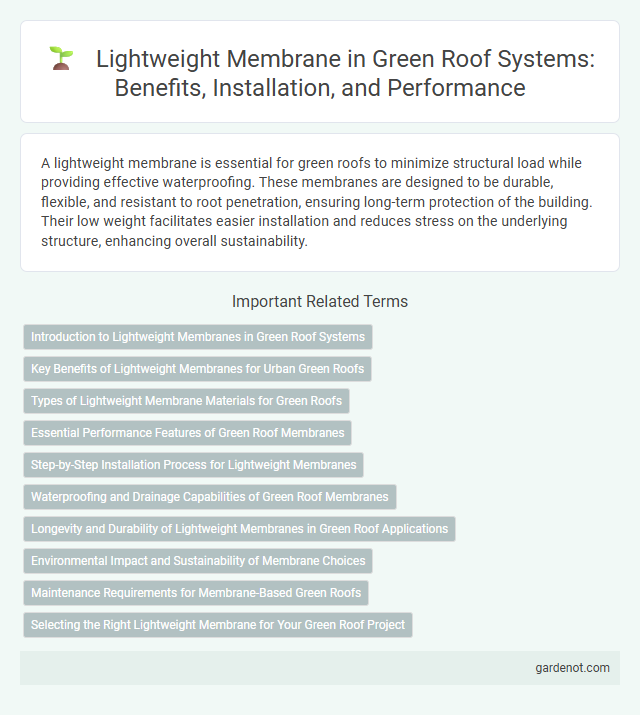A lightweight membrane is essential for green roofs to minimize structural load while providing effective waterproofing. These membranes are designed to be durable, flexible, and resistant to root penetration, ensuring long-term protection of the building. Their low weight facilitates easier installation and reduces stress on the underlying structure, enhancing overall sustainability.
Introduction to Lightweight Membranes in Green Roof Systems
Lightweight membranes in green roof systems serve as essential waterproofing layers that protect the building structure while minimizing additional weight load. These membranes are typically composed of flexible materials such as ethylene propylene diene monomer (EPDM) or thermoplastic polyolefin (TPO) designed for durability and resistance to UV radiation and weathering. Their lightweight nature enables easier installation and compatibility with various roof types, enhancing the overall performance and longevity of green roofs.
Key Benefits of Lightweight Membranes for Urban Green Roofs
Lightweight membranes used in urban green roofs significantly reduce structural load, enabling installation on a variety of existing buildings without major reinforcements. These membranes offer excellent waterproofing and root resistance, protecting the infrastructure from water damage and plant penetration. Their ease of installation and durability contribute to lower maintenance costs and enhanced long-term performance of green roof systems.
Types of Lightweight Membrane Materials for Green Roofs
Lightweight membrane materials for green roofs include thermoplastic polyolefin (TPO), ethylene propylene diene monomer (EPDM), and polyvinyl chloride (PVC), known for their durability and UV resistance. These materials provide effective waterproofing while minimizing structural load, making them ideal for urban green roof installations. Synthetic rubber membranes like EPDM offer flexibility and long lifespan, contributing to enhanced roof performance and sustainability.
Essential Performance Features of Green Roof Membranes
Lightweight membranes for green roofs ensure efficient water retention while providing excellent root resistance and UV stability, crucial for long-term durability. These membranes offer high tensile strength and flexibility to accommodate building movement and prevent leaks, maintaining roof integrity under extreme weather conditions. Their breathable structure supports proper drainage and vapor permeability, essential for healthy plant growth and building protection.
Step-by-Step Installation Process for Lightweight Membranes
Lightweight membrane installation for green roofs begins by thoroughly cleaning and preparing the roof surface to ensure proper adhesion. Next, the membrane rolls are carefully aligned and unrolled, with seams overlapped and sealed using manufacturer-recommended adhesives or heat-welding techniques to create a watertight barrier. Finally, the membrane is inspected for any air bubbles or wrinkles before installing protection layers and vegetation to complete the green roof system.
Waterproofing and Drainage Capabilities of Green Roof Membranes
Green roof lightweight membranes provide exceptional waterproofing by forming a durable barrier that prevents water infiltration, protecting the underlying building structure from moisture damage. These membranes are engineered with advanced drainage capabilities, allowing efficient water flow and preventing water accumulation that can compromise roof integrity. High-quality green roof membranes balance waterproofing and drainage, ensuring long-term performance and sustainability of vegetative roofing systems.
Longevity and Durability of Lightweight Membranes in Green Roof Applications
Lightweight membranes used in green roof applications feature advanced polymer compositions that enhance resistance to UV radiation, moisture, and temperature fluctuations, significantly extending their lifespan. Their robust mechanical properties prevent punctures and tears while maintaining flexibility, reducing maintenance needs and replacement costs. These membranes contribute to the long-term structural integrity and waterproofing performance of green roofs, ensuring sustainable and durable vegetation support systems.
Environmental Impact and Sustainability of Membrane Choices
Lightweight membranes used in green roofs significantly reduce the overall structural load, enabling the use of sustainable building materials and minimizing carbon footprint during construction. Selecting membranes made from recyclable or bio-based materials enhances environmental impact by reducing waste and promoting circular resource use. Durable, low-toxicity membranes extend roof lifespan, decreasing frequency of replacements and lowering long-term environmental costs.
Maintenance Requirements for Membrane-Based Green Roofs
Lightweight membranes used in green roofs require regular inspections to detect punctures, tears, or signs of wear that could compromise waterproofing. Maintenance procedures often include cleaning debris that can accumulate and cause damage, as well as ensuring that root barriers remain intact to prevent membrane penetration. Proper upkeep extends the membrane's lifespan and enhances the overall durability and efficiency of membrane-based green roof systems.
Selecting the Right Lightweight Membrane for Your Green Roof Project
Selecting the right lightweight membrane for your green roof project is crucial for ensuring durability, waterproofing, and load-bearing capacity. Opt for membranes made from high-quality materials such as EPDM or TPO, which offer excellent resistance to UV rays and root penetration. Proper membrane choice enhances system longevity and contributes to efficient stormwater management and thermal insulation.
Lightweight membrane Infographic

 gardenot.com
gardenot.com